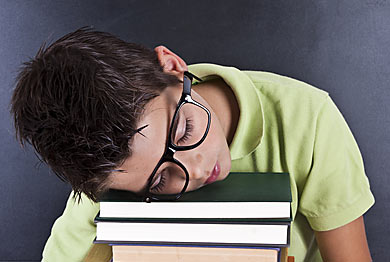 We all know how challenging it can be to make sure that our children have adequate sleep. Children have busy lives and quiet evenings at home are compromised by after school activities and homework. In addition, many children have poor sleep habits that contribute to their inability to fall asleep within a reasonable time and to stay asleep through the night.
We all know how challenging it can be to make sure that our children have adequate sleep. Children have busy lives and quiet evenings at home are compromised by after school activities and homework. In addition, many children have poor sleep habits that contribute to their inability to fall asleep within a reasonable time and to stay asleep through the night.
Approximately 20-30% of all children have problems related to sleep. Although approximately 27% of school age children do not get enough sleep, school age children are known to receive the least amount of attention regarding evaluation of their sleep. In a classroom of 20 students, five or six students will have not slept well the night before. In a school with a student population of 300, over 80 students will have sleeping problems. That equates to a least four full classrooms of students who did not sleep well!
So, what is sleep? Sleep is a reversible state where a person disengages and has a lack of response to their environment. Sleep is characterized by reduced activity and specific positioning such as laying down with eyes closed. We all have different stages in our sleep. Sleep cycles alternate throughout the night and last 90-110 minutes. REM (rapid eye movement) sleep is “dream sleep” and occurs primarily in the second half of the night in children. REM is characterized by dreaming / nightmares, absent skeletal muscle tone, low body temperature, eye movements, muscle twitching, and facial grimacing. REM occurs within 70-100 minutes after sleep onset and lasts for 5 minutes.
Non-REM sleep occurs primarily in the first half of the night and consists of three stages. N1 sleep is the sleep/wake transition characterized by jerking muscle movements. N1 sleep lasts 30 seconds to 5 minutes. Children are easy to awaken from this stage.
N2 sleep is true sleep and lasts 5-25 minutes. Specific brain waves include sleep spindles and K-complexes. N3 sleep is deep sleep. Patients are very hard to awaken from this stage. N3 sleep lasts 30-45 minutes and is followed by a brief arousal before going into a lighter sleep stage. Activities that occur in non-REM sleep include sleep walking and night terrors.
Recommendations from the National Sleep Foundation are that school age children need at least 9-11 hours of sleep at night. Inadequate sleep results in problems with health and psychosocial well-being. Sleepy children in the classroom may show poor impulse control, low levels of motivation, poor emotional control, poor comprehension of material, and poor time management skills. In addition to potentially falling asleep in class, children may exhibit risk taking behavior regardless of consequences, have poor short term memory, display problems processing information, show chronic tardiness, and may have a lot of physical complaints. A sleepy child cannot possibly reach their maximum potential!
Sleep is essential for a child’s biological and psychological health. Slow wave deep sleep is necessary to restore the body and is required for optimal learning. Sleep is needed to release growth hormones and is necessary for memory consolidation. REM, or dreaming sleep, is needed for emotional memory processing and is essential for growth and development of the central nervous system.
Learning issues affected by sleep include: cognitive and academic functioning, problems remaining alert, difficulty concentrating, and decreased executive functioning skills (generating hypotheses, abstract reasoning, and information processing). Poor sleep also affects behavior and may cause interference with emotional operations. Inadequate sleep may increase depression, increase risk taking behavior, worsen a lack of emotional control, and cause anxiety, aggression, and hyperactivity. Insufficient sleep has also been shown to decrease optimism and self-esteem. Poor sleep can cause weight gain, slowed growth, and changes in immune responses.
Physiological factors that affect sleep include: sleep apnea (prolonged pauses in breathing at night), low iron stores, limbs moving too much at night, bedwetting, circadian rhythm (internal clock) problems, and chronic illnesses such as asthma, epilepsy, and pain. Environmental factors include demands from school, extracurricular activities, electronic socializing, electronic media use, work, and early school start times.
Schools are ideal settings to be used to screen children for sleeping problems and to promote sleep education. Quick assessment tools such as the Epworth Sleepiness Scale (modified pediatric version) or the BEARS Sleep Questionnaire can be quickly and easily administered at the beginning of the school year, or any time when sleep problems are suspected. Schools can also be instrumental in promoting sleep hygiene education and supporting later school start times for middle and high school students. We owe it to our children to help them to achieve a better night’s sleep. Sleep assessment and education in the schools is a great way to start.

